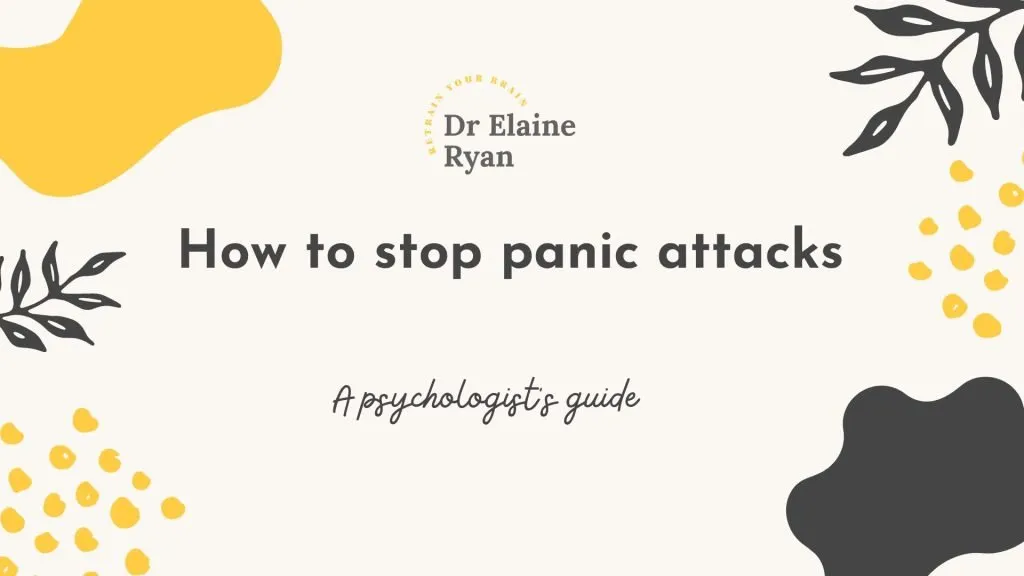About the author
Page last updated by Dr Elaine Ryan
Quick answer: Stay where you are, slow your breathing (4-in, 6-out), ground yourself with 5-4-3-2-1, remind yourself “this will pass,” and repeat for 1–3 minutes. These steps calm the fight-or-flight response and reduce symptoms fast.
- Stay put. Sit if you can.
- Breathe: in through the nose for 4s, hold 2s, out through the mouth for 6s. Repeat.
- Ground: 5 things you see, 4 touch, 3 hear, 2 smell, 1 taste.
- Reassure: “I’m safe. This will pass.”
If you’re unsure whether symptoms are panic or a medical issue, contact your GP or emergency services (112/999 in Ireland).
I’ve written extensively on the subject of panic attacks, but I understand that people are not sure where to start with panic, in that they just want them to stop but are not sure how. In today’s article, I am going to outline things that you can do right way that will help you stop having panic attacks, as well as more long-term solutions such as therapy, but importantly I am going to explain how and why each technique or therapy works. There are proven ways to stop them and understanding the “why” is just as important as knowing what to do because it helps build confidence in the process.
Table of contents
Online Course for Panic
Start right away – no appointment, completely confidential.
€199 for the full CBT + neuroscience course. 10-day no-questions refund.


How to Manage a Panic Attack in the Moment
When a panic attack strikes, it feels like all control is lost. As I’ve mentioned many times before I had panic disorder myself, and for me, I did not feel any control whatsoever until I fully understood what was happening, which is what I want to do for you now, is give you control back. It was my personal experience of panic attacks that propelled me into years of professional research and focused a large proportion of my professional career on helping people with anxiety disorders. There are concrete steps you can take to regain control during the attack. These techniques don’t just help reduce the panic in the moment—they also retrain your brain over time, teaching it that the situation isn’t dangerous.
Grounding Techniques
How to do it: The 5-4-3-2-1 technique helps distract your mind from the panic and pulls your attention back to the present. Start by focusing on:
- 5 things you can see: Describe them in detail (e.g., “I see a green plant with broad leaves”).
- 4 things you can touch: Feel textures around you (e.g., “I can feel the cool metal of my watch”).
- 3 things you can hear: Identify specific sounds (e.g., “I can hear birds outside”).
- 2 things you can smell: Notice scents, like food or fresh air (e.g., “I smell my perfume”).
- 1 thing you can taste: Focus on any taste in your mouth (e.g., “I can taste the mint from my gum”).
Why it works: Panic attacks often involve a “fight-or-flight” response, where your mind becomes hyper-focused on perceived danger. Grounding techniques interrupt this by redirecting your focus to the present and reminding your brain that there is no immediate threat. This shift reduces the physiological reactions of panic, such as rapid heartbeat or shortness of breath.
Controlled Breathing
How to do it: Controlled, deep breathing slows down your body’s panic response. Try the following:
- Breathe in slowly for 4 seconds, through your nose.
- Hold the breath for 2 seconds.
- Exhale slowly for 6 seconds, through your mouth.
- Repeat until you feel calmer.
Why it works: During a panic attack, you may start breathing too quickly or shallowly, which lowers the level of carbon dioxide in your blood. This can cause symptoms like dizziness or tingling, which make the panic worse. Slow, deep breaths restore the balance of oxygen and carbon dioxide, sending a signal to your brain that you are not in danger, helping to calm the nervous system.
Progressive Muscle Relaxation
How to do it: Start by tensing the muscles in your feet for about 5 seconds, then release. Slowly work your way up the body—calves, thighs, stomach, chest, arms, neck, and face—tensing each muscle group before relaxing them.
Why it works: When you’re anxious, your body holds tension without you realising it. By deliberately tensing and releasing your muscles, you become more aware of this tension, and the process of relaxing the muscles sends signals to the brain that it’s time to calm down. This helps to break the panic cycle by lowering your body’s overall stress response.
Mindful Awareness
How to do it: During a panic attack, instead of trying to fight the panic, try to observe your thoughts and sensations as if you’re a neutral observer. Say to yourself: “I’m noticing that my heart is beating fast. I’m feeling anxious, but I know this will pass.”
Why it works: Mindfulness teaches you to experience the sensations of a panic attack without becoming overwhelmed by them. When you stop fighting the sensations and start observing them, they lose some of their power. Over time, your brain learns that these sensations aren’t as dangerous as they feel, reducing the frequency of future attacks.
Positive Affirmations
How to do it: Repeat calming phrases to yourself, either out loud or in your mind. For example: “This is just a panic attack; it will pass. I am safe.” Keep repeating these affirmations to counter the catastrophic thoughts that fuel the panic. I personally found this useful for panic during sleep.
Why it works: Panic attacks are often accompanied by catastrophic thinking—thoughts like “I’m going to die” or “I’m losing control.” Positive affirmations help reframe these thoughts, giving you something concrete to focus on that contradicts the panic. By repeating positive affirmations, you help break the cycle of fear.


Panic Attack FAQs
Use slow, regular breathing (e.g., inhale 4s, hold 2s, exhale 6s) and a grounding exercise like 5-4-3-2-1 to anchor your attention. These calm the fight-or-flight response and the symptoms ease as CO? levels normalise. See the NHS coping steps for panic attacks.
Most panic attacks peak within minutes and are over in about 5–30 minutes. The sensations are frightening but not dangerous. See HSE guidance on panic attacks for duration and self-help.
Talk to your GP if panic is affecting your life, or if you’re unsure whether symptoms are anxiety or something medical. Call 112/999 or go to ED if you have severe chest pain, new neurological symptoms, or feel at immediate risk. See HSE guidance on emergencies and urgent mental health help.
Modern guidance focuses on paced breathing and grounding; paper-bag breathing is not routinely recommended because symptoms can occasionally be due to other causes. Use controlled breathing methods instead and discuss options with your clinician. Why paper bag breathing is not recommended (full explainer.)
What are Panic Attacks?
I won’t go into detail what they are as I have already covered this in depth in this article, but will say panic attacks are intense bursts of anxiety that come on suddenly and feel terrifying. Symptoms include a racing heartbeat, dizziness, shortness of breath, and a sense of impending doom. These attacks are the body’s way of responding to a perceived threat, even though no real danger is present.
Long-Term Strategies to Stop Panic Attacks
Cognitive Behavioural Therapy (CBT)
How it works: In CBT, you learn to identify the specific thoughts and beliefs that trigger panic attacks. A therapist will help you challenge these thoughts and replace them with more balanced, realistic ones. For example, if your first thought during a panic attack is, “I’m going to pass out,” CBT teaches you to challenge this thought with evidence: “I’ve had this feeling before, and I never passed out.”
Read more on the model of CBT in this article, and please see here if you are interested in how CBT can help with panic attacks.
Why it works: CBT is effective because it directly targets the thought patterns that drive panic attacks. By learning to challenge these thoughts, you can change your emotional and physical reactions. Over time, the brain learns not to associate certain thoughts or sensations with danger, breaking the cycle of panic.
Example: One client used to experience panic attacks while driving. Through CBT, they learned to challenge the thought “I’ll lose control of the car and crash.” Instead, they began thinking, “I’ve driven hundreds of times without incident. This is just my anxiety talking.” Eventually, the client was able to drive without triggering a panic attack.
Exposure Therapy
How it works: In exposure therapy, you gradually expose yourself to situations that trigger your panic attacks in a safe, controlled environment. For example, if you fear crowded places, your therapist might first have you visualise being in a crowd, then slowly build up to standing in a crowded space. Throughout the process, you’ll use the calming techniques you’ve learned.
Why it works: Avoidance keeps panic alive by reinforcing the belief that certain situations are dangerous. Exposure therapy helps you unlearn that fear by gradually teaching your brain that these situations aren’t harmful. Over time, this reduces the frequency and severity of your panic attacks.
Example: If you fear having a panic attack in public, exposure therapy might start with walking into a busy café for just a few minutes and using your breathing techniques to stay calm. Over time, you would spend longer periods in these environments until they no longer trigger panic.
Lifestyle Adjustments
How to do it: Simple lifestyle changes can help manage stress and anxiety, reducing the likelihood of panic attacks:
- Exercise regularly: Even light exercise like walking can reduce overall anxiety by releasing feel-good chemicals like endorphins.
- Limit caffeine and alcohol: These substances can stimulate the nervous system and increase anxiety.
- Get enough sleep: Sleep deprivation can heighten anxiety levels, making you more prone to panic attacks. You can read more about sleep and panic disorder in this article.
Why it works: Panic attacks often occur when your body and mind are under increased stress. By taking steps to reduce your overall anxiety levels, you create a foundation of calm that makes it less likely for a panic attack to occur in the first place. For example, regular exercise reduces stress hormones like cortisol, while proper sleep helps regulate your mood and anxiety levels.
Relaxation Training
How to do it: Incorporate daily relaxation practices like meditation, yoga, or mindfulness into your routine. These practices teach your body to stay calm, even in stressful situations. You can read more on guided relaxation here.
Why it works: Over time, regular relaxation training helps lower your baseline anxiety level, making you more resilient to stress. When your overall anxiety is lower, you’re less likely to experience panic attacks. Additionally, these practices help you develop skills to calm your body when you feel panic building.
How Therapy Stops Panic Attacks
How it works: Therapy doesn’t just teach you to cope with panic attacks; it teaches you to stop them altogether by addressing their root cause. The first step in therapy is understanding your unique triggers and the patterns that maintain your panic. Then, using techniques like CBT and exposure therapy, you learn how to confront these triggers and change your reactions to them.
Step-by-step approach in therapy:
- Identify Triggers: In therapy, you’ll work to uncover the specific situations, thoughts, or physical sensations that trigger your panic attacks.
- Change Thought Patterns: Through CBT, you’ll learn to identify unhelpful thoughts that escalate anxiety and replace them with more realistic, calming thoughts.
- Stop avoiding things you think will trigger panic: When you start exposure therapy, you will be shown how to do the things you fear, without having a panic attack, which not only gives you confidence to try more, but help to build resilence. This new confidence and resilience means fewer panic attacks.
Why it works: Therapy works by retraining your brain. The more times you do things in a specific way, that previously made you panic, the more your brain learns that you are safe. When I say in a specific way, I mean doing the things in the way, I or another therapist has taught you, to keep you calm during the process. You keep doing this, over and over, and each time you shall be less anxious; the fight or flight response stops!
How I Can Help
If you would like my help please free to contact the clinic here.
Next steps:Panic Attack Counselling (hub) · CBT for Panic Attacks · Exposure therapy for panic
